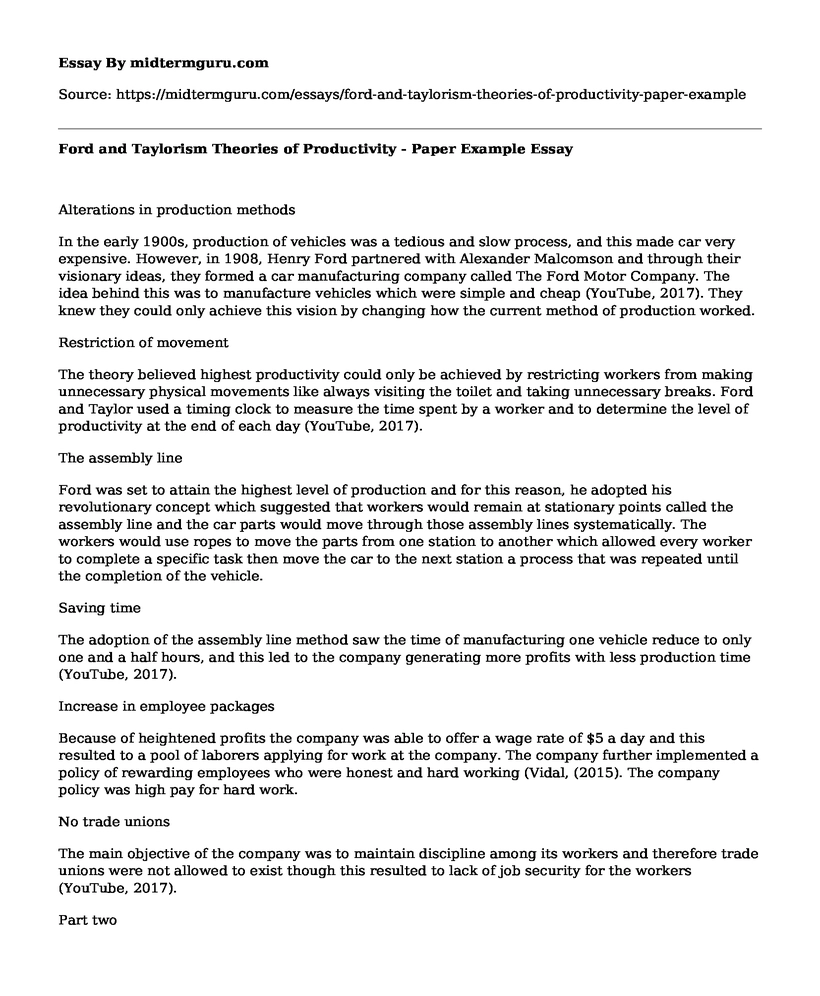Alterations in production methods
In the early 1900s, production of vehicles was a tedious and slow process, and this made car very expensive. However, in 1908, Henry Ford partnered with Alexander Malcomson and through their visionary ideas, they formed a car manufacturing company called The Ford Motor Company. The idea behind this was to manufacture vehicles which were simple and cheap (YouTube, 2017). They knew they could only achieve this vision by changing how the current method of production worked.
Restriction of movement
The theory believed highest productivity could only be achieved by restricting workers from making unnecessary physical movements like always visiting the toilet and taking unnecessary breaks. Ford and Taylor used a timing clock to measure the time spent by a worker and to determine the level of productivity at the end of each day (YouTube, 2017).
The assembly line
Ford was set to attain the highest level of production and for this reason, he adopted his revolutionary concept which suggested that workers would remain at stationary points called the assembly line and the car parts would move through those assembly lines systematically. The workers would use ropes to move the parts from one station to another which allowed every worker to complete a specific task then move the car to the next station a process that was repeated until the completion of the vehicle.
Saving time
The adoption of the assembly line method saw the time of manufacturing one vehicle reduce to only one and a half hours, and this led to the company generating more profits with less production time (YouTube, 2017).
Increase in employee packages
Because of heightened profits the company was able to offer a wage rate of $5 a day and this resulted to a pool of laborers applying for work at the company. The company further implemented a policy of rewarding employees who were honest and hard working (Vidal, (2015). The company policy was high pay for hard work.
No trade unions
The main objective of the company was to maintain discipline among its workers and therefore trade unions were not allowed to exist though this resulted to lack of job security for the workers (YouTube, 2017).
Part two
In an information and Technology company that I had the opportunity to work with in the past, the idea of dividing long work processes in to different key segments was found to be a fundamental key to success. The organization also upheld the policy of reducing strenuous work for individuals and this led to a great deal of saving time and minimizing cost. The organization was also keen on encouraging skills and talents with a close focus on retention of talents and market good will. The single principle that this company could adopt is that of creating job security for its employees as this will ensure low employee turnover and high productivity.
Would workers in Australia, America or Europe accept the Taylorism in this form today?
In the modern world it would be difficult if not totally impossible for workers in Australia, America or Europe to accept Ford and Taylorism in its original structure. This is simply because times have changed with the advent of technology and automation services and it would not be relevant to apply this theory whatsoever (Witzel & Warner, 2015).
Consider the design of scripts for use in Call Centres, can you see Taylorism in that?
The operations of a call center are divided into different sections in regards to niche and therefore Taylorism can be absolutely applied to some extent but not in totality. In a call center tasks can be divided depending on the area of expertise but the whole concept of restriction of movement and abolition of trade unions cannot apply in this sector (Sinha, & Gabriel, 2016).
This clip is showing history from 100 years ago. Some would say that the world has moved on and these ideas are out of date. However, could there be parts of the world today for which these ideas might be just what they need? Explain.
Yes, many industries across the world would certainly benefit from using the Taylorism theory. It goes without saying that the concepts of labor division, employee rewarding, time-saving methods and mass production are recipes for success in any organization. These principles continue to remain important in organizations many centuries later. However, it can be maintained that restriction of movement and lack of trade unions can be detrimental for any organization and should not be considered (Witzel & Warner, 2015).
References
Sinha, S. and Gabriel, Y., 2016. Call Centre Work: Taylorism with a Facelift. Re-Tayloring Management: Scientific Management a Century On, p.87.
Witzel, M. and Warner, M., 2015. Taylorism revisited: Culture, management theory and paradigm-shift. Cambridge Judge Business SchoolWorking paper number 01/2015.
YouTube. (2017). Ford and Taylor Scientific Management (Edited). [online] Available at: https://www.youtube.com/watch?v=8PdmNbqtDdI [Accessed 9 Jan. 2017].
Cite this page
Ford and Taylorism Theories of Productivity - Paper Example. (2021, May 28). Retrieved from https://midtermguru.com/essays/ford-and-taylorism-theories-of-productivity-paper-example
If you are the original author of this essay and no longer wish to have it published on the midtermguru.com website, please click below to request its removal:
- Culture, Climate, and Ethics in a Company - Paper Example
- Literature Review of The New Role of the World Bank by Michael A Clemens and Michael Kremer
- Essay on the Effect Leadership Has on the Creativity and Innovation of the Company
- Essay Sample on Leadership Collaboration to Enhance Minimal Expenditure
- Analyzing Governance and Knowledge Management - Essay Sample
- Project Management: Maximizing Efficiency with Minimum Costs - Research Paper
- Acknowledging Contributions - Essay Sample







